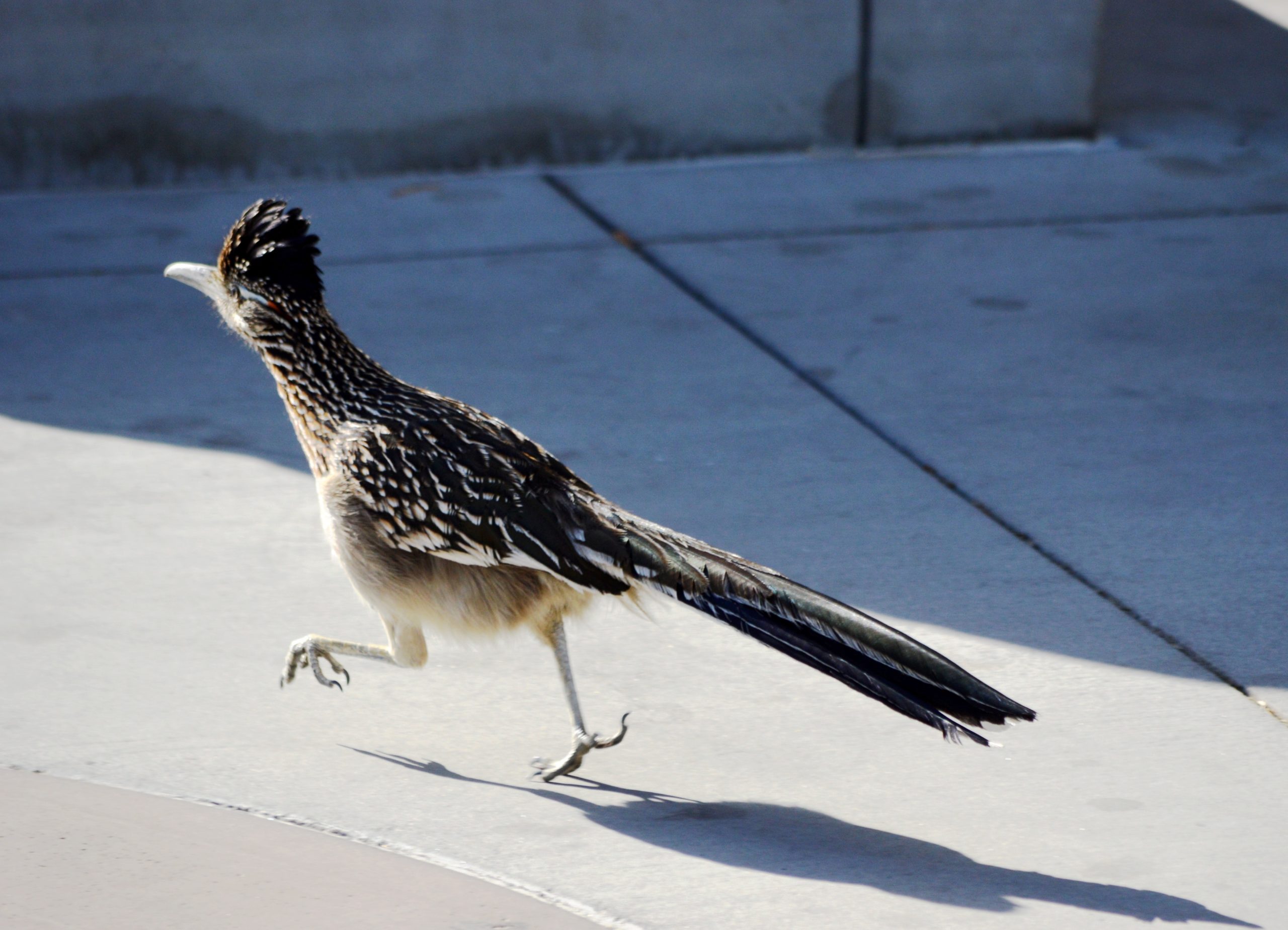Runaway Roadrunner Dashes into Motorsports Office, Jumps on Monitor, Stares at Owner, Runs Out, Hundreds of Miles North of Home-Range Breaking UT State Record

(EnviroNews Utah) — Provo, Utah — On a July night in the summer of 2024, David Kirkham was watching a documentary on YouTube with his family about the greater roadrunner (Geococcyx californianus) — the fastest running feathered creature on Earth that can also fly. Never in his wildest dreams did he imagine one of the lil’ blistering birds would blaze into his office, jump up on his computer monitor and stare him straight in the face — only days later — hundreds of miles north of its relatively small native habitat (roadrunners do not migrate).
Kirkham is the owner of Kirkham Motorsports in Provo, Utah – the home of Brigham Young University (BYU) and an ever-growing, bustling bosom of activity in the northern part of the state. The runaway roadrunner in question is indeed the same species famous for antagonizing the legendary Wile E. Coyote in the Warner Bros cartoons from 1949-2014, but the bird has never before been spotted in Utah County.
Kirkham recounted the exciting event to EnviroNews in an exclusive, saying this:
I heard a noise across the room, then he jumped up onto one of my monitors. He was literally just two feet away from me staring down from my screen. He was as surprised to see me as I was to see him. It was truly a beautiful moment.
Roadrunners, also known as chaparral birds or chaparral cocks, are fast-running ground cuckoos with long tails and crests. The species has been clocked at speeds over 20 miles-per-hour on tiny stick legs only a few inches long. They are non-migratory and inhabit the arid lowland and mountainous shrublands of the southwestern U.S. and northern Mexico.

While reasonably common in the southern counties of Utah, the Beehive State is a very large place, meaning Kirkham’s sighting represents the farthest north a roadrunner has ever been recorded in the state and one of the northern-most sightings ever recorded. So, how on Earth did the little fella get there? Roadrunners are sprinters not marathon runners; could it have actually ran this far?
Faith Heaton Jolley is a public information officer and outreach section assistant chief for the Utah Division of Natural Resources (DNR). She told EnviroNews this in an email:
The situation of the bird being inside a building strongly suggests it was artificially transported — likely accidentally. Roadrunners only manage short flights of 10 to 20 feet, so it is unlikely a natural weather system transported the bird. The most likely possibility is that it hitched a ride on a cargo or transport vehicle from the southern part of the state or somewhere like St. George, [Utah] or Texas where they can be found in more urban and suburban areas. It then likely escaped near an unloading dock, entering the nearby building. This is a good reminder that care should be taken to avoid moving an animal outside of its range.
Being poor flyers, roadrunners usually opt to run away from their many predators which include raccoons, skunks, domestic cats, a variety of hawks, and yes, you’ve guessed it, coyotes. On the intermittent occasions when they do take to the air, they can be identified by a white crescent in the primary feathers of their rounded wings.
This particular species could best be described as an opportunistic omnivore partial to grasshoppers, crickets, caterpillars and beetles — adding the occasional lizard or snake to the menu. It also eats berries, fruits and seeds, none of which can be found in the offices of a motorsports company.
So what happened next? How did the mysteriously transplanted, cheeky roadrunner make its escape? Kirkham explained it this way:
Unsurprisingly, he was pretty nervous so I just gently got behind him so he could find his way back out. After a bit I think he could see I wasn’t a threat to him. I slowly opened my office door until he could get out and I followed him until he found a big bay door to escape into the wild of Provo. He ran just like the bird in the cartoon. It was pretty crazy. His feet were moving fast but his head didn’t even bounce up and down. And then he just took off.
While it was a day to remember for Kirkham, the sighting is not being treated as “ecologically significant” by Heaton Jolley and her DNR colleagues. “Wildlife doesn’t always fit into the ranges, parameters, and expectations we use to categorize them,” she explained. “It’s actually not even on the list of most exciting wildlife discoveries in this area. Birds in general can show up in some unexpected places.”

Roadrunner enters Kirkham Motorsports in Provo, Utah — Photo: David Kirkham
Greater roadrunners have been known to wander long distances out of their usual range and have been recently expanding to the north and east. Until now, the small town of Delta held the Utah state record for the most northerly roadrunner sighting. But according to Heaton Jolley, there have perhaps been sightings further north in the U.S. including at least one in Oregon.
But now to answer the question you’ve all been dying to ask. No, sadly, the roadrunner does not make a ‘meep-meep’ sound like its cartoon brother; a soothing dove-like “coo” is all it can muster. Another TV-based misconception is that roadrunners are faster than coyotes. In fact, a coyote’s fastest sprinting speed of 64 km/h (40 mph) is roughly twice that of the still-speedy bird.
Nevertheless, it’s a fantastic and fascinating species which has delighted many a birdwatcher and inspired one of the most successful cartoon shows of all time. And as for Mr. Kirkham, he says the mysterious runaway roadrunner turned a routine office shift into a “very special day” indeed.
As of the time of the publishing of this report, there have been no further reports of the roadrunner since the initial sighting and release from the building.
Usain Bolt vs The Roadrunner (The REAL Roadrunner) – Who Would Win? – EnviroNews | The Environmental News Specialists
(EnviroNews World News) – Well, the header on this story pretty much says it all. It’s hard to imagine a bird, weighing less than one pound, and having legs only a few inches long, could either keep up with, or even beat Usain Bolt, the Jamaican track-and-field sprint…
FILM AND ARTICLE CREDITS
- Dan Keel - Journalist, Author



